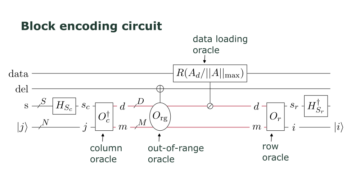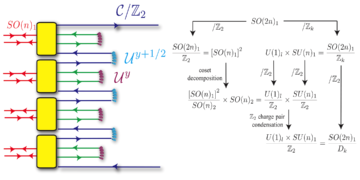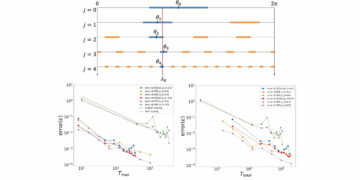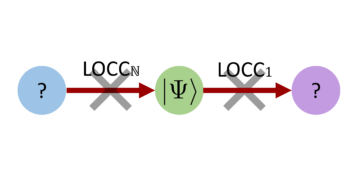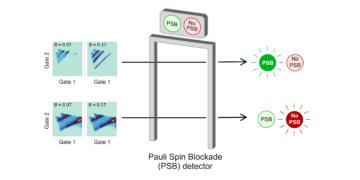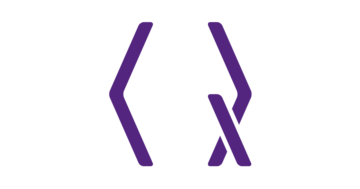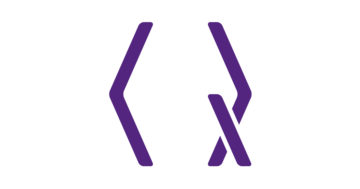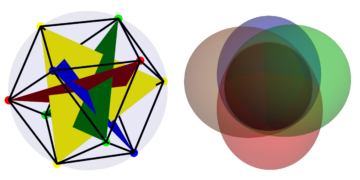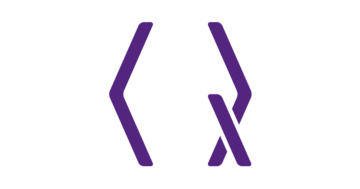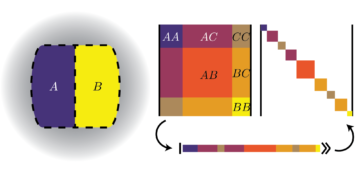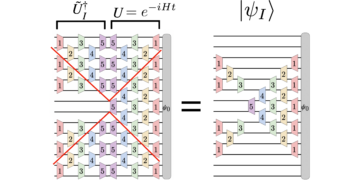1نظریاتی ڈویژن، لاس الاموس نیشنل لیبارٹری، لاس الاموس، NM 87545، USA۔
2Computer, Computational, and Statistical Sciences Division, Los Alamos National Laboratory, Los Alamos, NM 87545 USA.
اس کاغذ کو دلچسپ لگتا ہے یا اس پر بات کرنا چاہتے ہیں؟ SciRate پر تبصرہ کریں یا چھوڑیں۔.
خلاصہ
We propose a continuous-variable (CV) SWAP test that requires no ancilla register, thereby generalizing the ancilla-free SWAP test for qubits. In this ancilla-free CV SWAP test, the computational basis measurement is replaced by photon number-resolving measurement, and we calculate an upper bound on the error of the overlap estimate obtained from a finite Fock cutoff in the detector. As an example, we show that estimation of the overlap of pure, centered, single-mode Gaussian states of energy $E$ and squeezed in opposite quadratures can be obtained to error $epsilon$ using photon statistics below a Fock basis cutoff $O(Eln epsilon^{-1})$. This cutoff is greatly reduced to $E + O(sqrt{E}ln epsilon^{-1})$ when the states have rapidly decaying Fock tails, such as coherent states. We show how the ancilla-free CV SWAP test can be extended to many modes and applied to quantum algorithms such as variational compiling and entanglement spectroscopy in the CV setting. For the latter we also provide a new algorithm which does not have an analog in qubit systems. The ancilla-free CV SWAP test is implemented on Xanadu’s 8-mode photonic processor in order to estimate the vacuum probability of a two-mode squeezed state.
Featured image: One-layer linear optical circuit for a two-mode ancilla-free continuous variable SWAP test. $U_{text{BS}}({piover 4},0)$ is a 50:50 beamsplitter that maps tensor products of Fock states to eigenvectors of the SWAP gate. Local photon number-resolving measurement outcomes $n$ and $m$ are indicated.
مقبول خلاصہ
In this paper we propose a continuous-variable (CV) SWAP test that requires no ancilla register, thereby generalizing the ancilla-free SWAP test for qubits. The quantum circuit for the algorithm consists of a single layer of 50-50 beam splitter unitaries followed by photon number detection measurements. The overlap can be estimated by running this quantum circuit repeatedly and processing the measurement outcomes classically. In an ideal setting the estimator is unbiased. We upper-bound the systematic error that results when the photon detectors have a threshold beyond which they saturate in practice. We also upper-bound the number of times the circuit needs to be ran to achieve a desired overall error.
We show how the ancilla-free CV SWAP test can be extended to many modes and applied to quantum algorithms such as variational compiling and entanglement spectroscopy in the CV setting. For the latter we also provide a new algorithm which does not have an analog in qubit systems. We also observe that the ancilla-free CV SWAP test along with the analogous algorithm for qubits can be applied in hybrid quantum systems, such as cavity quantum electrodynamics. Finally, we use the ancilla-free CV SWAP test to calculate the vacuum probability of a two-mode squeezed state on Xanadu’s 8-mode photonic processor.
► BibTeX ڈیٹا
► حوالہ جات
ہے [1] Nicolas C. Menicucci, Peter van Loock, Mile Gu, Christian Weedbrook, Timothy C. Ralph, and Michael A. Nielsen. “Universal quantum computation with continuous-variable cluster states”. Phys. Rev. Lett. 97, 110501 (2006).
https:///doi.org/10.1103/PhysRevLett.97.110501
ہے [2] Nicolas C. Menicucci. “Fault-tolerant measurement-based quantum computing with continuous-variable cluster states”. Phys. Rev. Lett. 112, 120504 (2014).
https:///doi.org/10.1103/PhysRevLett.112.120504
ہے [3] Kosuke Fukui, Akihisa Tomita, Atsushi Okamoto, and Keisuke Fujii. “High-threshold fault-tolerant quantum computation with analog quantum error correction”. Phys. Rev. X 8, 021054 (2018).
https:///doi.org/10.1103/PhysRevX.8.021054
ہے [4] Kyungjoo Noh and Christopher Chamberland. “Fault-tolerant bosonic quantum error correction with the surface–Gottesman-Kitaev-Preskill code”. Phys. Rev. A 101, 012316 (2020).
https:///doi.org/10.1103/PhysRevA.101.012316
ہے [5] J. Eli Bourassa, Rafael N. Alexander, Michael Vasmer, Ashlesha Patil, Ilan Tzitrin, Takaya Matsuura, Daiqin Su, Ben Q. Baragiola, Saikat Guha, Guillaume Dauphinais, Krishna K. Sabapathy, Nicolas C. Menicucci, and Ish Dhand. “Blueprint for a Scalable Photonic Fault-Tolerant Quantum Computer”. Quantum 5, 392 (2021).
https://doi.org/10.22331/q-2021-02-04-392
ہے [6] A. K. Pati and S. L. Braunstein. “Deutsch-Jozsa Algorithm for Continuous Variables” (2002). arXiv:quant-ph/0207108.
arXiv:quant-ph/0207108
ہے [7] R. C. Wagner and V. M. Kendon. “The continuous-variable Deutsch–Jozsa algorithm using realistic quantum systems”. J. Phys. A: Math. Theor. 45, 244015 (2012).
https://doi.org/10.1088/1751-8113/45/24/244015
ہے [8] A. K. Pati, S. L. Braunstein, and S. Lloyd. “Quantum searching with continuous variables” (2000). arXiv:quant-ph/0002082.
arXiv:quant-ph/0002082
ہے [9] ہیری بوہرمین، رچرڈ کلیو، جان واٹروس، اور رونالڈ ڈی وولف۔ "کوانٹم فنگر پرنٹنگ"۔ طبیعیات Rev. Lett. 87، 167902 (2001)۔
https:///doi.org/10.1103/PhysRevLett.87.167902
ہے [10] Juan Carlos Garcia-Escartin and Pedro Chamorro-Posada. “SWAP test and Hong-Ou-Mandel effect are equivalent”. Phys. Rev. A 87, 052330 (2013).
https:///doi.org/10.1103/PhysRevA.87.052330
ہے [11] L. Cincio, Y. Subaşı, A. T. Sornborger, and P. J. Coles. “Learning the quantum algorithm for state overlap”. New J. Phys. 20, 113022 (2018).
https://doi.org/10.1088/1367-2630/aae94a
ہے [12] Kok Chuan Tan and Tyler Volkoff. “Variational quantum algorithms to estimate rank, quantum entropies, fidelity, and Fisher information via purity minimization”. Phys. Rev. Research 3, 033251 (2021).
https:///doi.org/10.1103/PhysRevResearch.3.033251
ہے [13] Sonika Johri, Damian S. Steiger, and Matthias Troyer. “Entanglement spectroscopy on a quantum computer”. Phys. Rev. B 96, 195136 (2017).
https:///doi.org/10.1103/PhysRevB.96.195136
ہے [14] Y. Subaşı, L. Cincio, and P. J. Coles. “Entanglement spectroscopy with a depth-two quantum circuit”. J. Phys. A: Math. Theor. 52, 044001 (2019).
https://doi.org/10.1088/1751-8121/aaf54d
ہے [15] J. Yirka and Y. Subaşı. “Qubit-efficient entanglement spectroscopy using qubit resets”. Quantum 5, 535 (2021).
https://doi.org/10.22331/q-2021-09-02-535
ہے [16] T Brun. “Measuring polynomial functions of states”. Quantum Information Processing 4, 401 (2004).
https://doi.org/10.26421/QIC4.5-6
ہے [17] Jordan Cotler, Soonwon Choi, Alexander Lukin, Hrant Gharibyan, Tarun Grover, M. Eric Tai, Matthew Rispoli, Robert Schittko, Philipp M. Preiss, Adam M. Kaufman, Markus Greiner, Hannes Pichler, and Patrick Hayden. “Quantum virtual cooling”. Phys. Rev. X 9, 031013 (2019).
https:///doi.org/10.1103/PhysRevX.9.031013
ہے [18] ولیم جے ہگنس، سیم میکارڈل، تھامس ای او برائن، جونہو لی، نکولس سی روبن، سرجیو بوکسو، کے برگیٹا وہلی، ریان بابش، اور جیروڈ آر میک کلین۔ "کوانٹم ایرر کم کرنے کے لیے ورچوئل ڈسٹلیشن"۔ طبیعیات Rev. X 11, 041036 (2021)۔
https:///doi.org/10.1103/PhysRevX.11.041036
ہے [19] Zoë Holmes, Nolan Coble, Andrew T Sornborger, and Yiğit Subaşı. “On nonlinear transformations in quantum computation” (2021). arXiv:2112.12307.
آر ایکس سی: 2112.12307
ہے [20] O. Bratteli and D. W. Robinson. “Operator algebras and quantum statistical mechanics 2”. Springer, Berlin. (1997).
ہے [21] A. S. Holevo. “Quantum systems, channels, information”. de Gruyter, Berlin/Boston. (2012).
ہے [22] Matthew B. Hastings, Iván González, Ann B. Kallin, and Roger G. Melko. “Measuring Renyi Entanglement Entropy in Quantum Monte Carlo Simulations”. Phys. Rev. Lett. 104, 157201 (2010).
https:///doi.org/10.1103/PhysRevLett.104.157201
ہے [23] R. Durrett. “Probability, 4th ed.”. Cambridge University Press. (2010).
ہے [24] J. M. Arrazola, V. Bergholm, K. Bradler, T. R. Bromley, M. J. Collins, I. Dhand, A. Fumagalli, T. Gerrits, A. Goussev, L. G. Helt, J. Hundal, T. Isacsson, R. B. Israel, J. Izaac, S. Jahangiri, R. Janik, N. Killoran, S. P. Kumar, J. Lavoie, A. E. Lita, D. H. Mahler, M. Menotti, B. Morrison, S. W. Nam, L. Neuhaus, H. Y. Qi, N. Quesada, A. Repingon, K. K. Sabapathy, M. Schuld, D. Su, J. Swinarton, A. Szava, K. Tan, P. Tan, V. D. Vaidya, Z. Vernon, Z. Zabaneh, and Y. Zhang. “Quantum circuits with many photons on a programmable nanophotonic chip”. Nature 591, 54 (2021).
https://doi.org/10.1038/s41586-021-03202-1
ہے [25] Yvonne Y. Gao, Brian J. Lester, Kevin S. Chou, Luigi Frunzio, Michel H. Devoret, Liang Jiang, S. M. Girvin, and Robert J. Schoelkopf. “Entanglement of bosonic modes through an engineered exchange interaction”. Nature 566, 509 (2019).
https://doi.org/10.1038/s41586-019-0970-4
ہے [26] I. Pietikainen, O. Cernatik, S. Puri, R. Filip, and S. M. Girvin. “Controlled beam splitter gate transparent to dominant ancilla errors”. Quantum Sci. Technol. 7, 035025 (2022).
https://doi.org/10.1088/2058-9565/ac760a
ہے [27] ولیم آر کلیمینٹس، پیٹر سی ہمفریز، بینجمن جے میٹکلف، ڈبلیو سٹیون کولتھمر، اور ایان اے والمسلے۔ "یونیورسل ملٹی پورٹ انٹرفیرو میٹر کے لیے بہترین ڈیزائن"۔ آپٹیکا 3، 1460–1465 (2016)۔
https:///doi.org/10.1364/OPTICA.3.001460
ہے [28] O. Bratteli and D. W. Robinson. “Operator algebras and quantum statistical mechanics 1”. Springer, Berlin. (1987).
ہے [29] L. Mandel and E. Wolf. “Optical coherence and quantum optics”. Cambridge University Press. (1995).
ہے [30] T. J. Volkoff. “Strategies for variational quantum compiling of a zero-phase beamsplitter on the Xanadu X8 processor” (2022). arXiv:2202.01161.
آر ایکس سی: 2202.01161
ہے [31] T. J. Volkoff. “Efficient trainability of linear optical modules in quantum optical neural networks”. J. Russ. Laser Res. 42, 250 (2021).
https://doi.org/10.1007/s10946-021-09958-1
ہے [32] Tyler Volkoff, Zoë Holmes, and Andrew Sornborger. “Universal compiling and (no-)free-lunch theorems for continuous-variable quantum learning”. PRX Quantum 2, 040327 (2021).
https:///doi.org/10.1103/PRXQuantum.2.040327
ہے [33] Mateus Araújo, Adrien Feix, Fabio Costa, and Časlav Brukner. “Quantum circuits cannot control unknown operations”. New Journal of Physics 16, 093026 (2014).
https://doi.org/10.1088/1367-2630/16/9/093026
ہے [34] Y. Quek, E. Kaur, and M. M. Wilde. “Multivariate trace estimation in constant quantum depth” (2022). arXiv:2206.15405.
آر ایکس سی: 2206.15405
ہے [35] Ulysse Chabaud, Eleni Diamanti, Damian Markham, Elham Kashefi, and Antoine Joux. “Optimal quantum-programmable projective measurement with linear optics”. Phys. Rev. A 98, 062318 (2018).
https:///doi.org/10.1103/PhysRevA.98.062318
ہے [36] C. M. Herdman, P.-N. Roy, R. G. Melko, and A. Del Maestro. “Entanglement area law in superfluid $^{4}$He”. Nat. Phys. 13, 556 (2017).
https://doi.org/10.1038/NPHYS4075
ہے [37] Ashley Montanaro and Ronald de Wolf. “A survey of quantum property testing”. Pages 1–81. Number 7 in Graduate Surveys. Theory of Computing Library. (2016).
https:///doi.org/10.4086/toc.gs.2016.007
ہے [38] C.-H. Nguyen, K.-W. Tseng, G. Gleb Maslennikov, H. C. J. Gan, and D. Matsukevich. “Experimental SWAP test of infinite dimensional quantum states” (2021). arXiv:2103.10219.
آر ایکس سی: 2103.10219
کی طرف سے حوالہ دیا گیا
[1] Tyler J. Volkoff, “Strategies for Variational Quantum Compiling of a Zero-Phase Beam Splitter on the Xanadu X8 Processor”, Journal of Russian Laser Research (2022).
مذکورہ بالا اقتباسات سے ہیں۔ Crossref کی طرف سے پیش خدمت (آخری بار کامیابی کے ساتھ 2022-09-13 14:39:28)۔ فہرست نامکمل ہو سکتی ہے کیونکہ تمام ناشرین مناسب اور مکمل حوالہ ڈیٹا فراہم نہیں کرتے ہیں۔
On SAO/NASA ADS کاموں کے حوالے سے کوئی ڈیٹا نہیں ملا (آخری کوشش 2022-09-13 14:39:28)۔
یہ مقالہ کوانٹم میں کے تحت شائع کیا گیا ہے۔ Creative Commons انتساب 4.0 انٹرنیشنل (CC BY 4.0) لائسنس کاپی رائٹ اصل کاپی رائٹ ہولڈرز جیسے مصنفین یا ان کے اداروں کے پاس رہتا ہے۔


